#its just paraphyletic.....
Explore tagged Tumblr posts
Text
ok ive explained this before but the idea that only monophyletic groups are coherent in biology is such nonsense. its kind of hard to explain just look at this diagram

so, clearly polyphyletic groups are nonsense. theres no rules. but paraphyletic groups are very reasonable! "everything descended from this organism, but not this other organism". "monkey" is a coherent group! with this you can even say "fish" is a coherent group

fish is evertyhing in vertebrates but not tetrapoda! its a good category! it includes all the fishy animals that arent mammals or invertebrates. and invertebrates shouldnt be fish because theyre totally different inside (but inside, pretty much all the vertebra are pretty similar). its a great category
315 notes
·
View notes
Text
Round 2 - Chordata - Lissamphibia

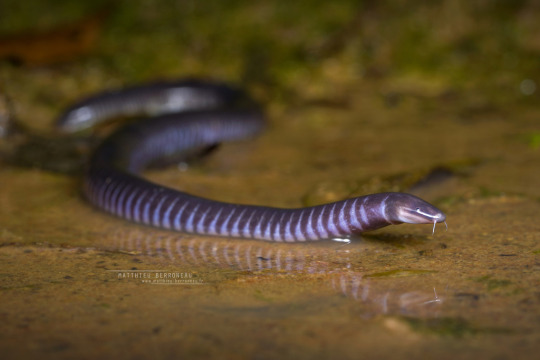


(Sources - 1, 2, 3, 4)
Lissamphibia is a subclass of tetrapods that includes all modern amphibians, including the orders Anura (“frogs”), Urodela (“salamanders”), and Gymnophiona (“caecilians). There are roughly 8,000 species of lissamphibians, of which nearly 90% are frogs.
Lissamphibians use their skin as a secondary respiratory interface. Some small terrestrial salamanders and frogs even lack lungs, relying entirely on their skin to breathe. To compensate for their thin and delicate skin, amphibians have evolved mucous glands, primarily on their heads, backs and tails, to keep their skin from drying out. Most species of amphibian have parotoid glands that secrete the neurotoxin bufotoxin as a defense mechanism. These are located behind the ears of toads, along the backs of frogs, behind the eyes of salamanders, and on the upper surface of caecilians. Some amphibian toxins can be lethal to humans while others have little effect. Some salamanders and caecilians have Ampullae of Lorenzini: pores able to detect electric fields.
Young lissamphibians generally undergo metamorphosis from an aquatic larval form with gills to an air-breathing adult form with lungs. Some amphibians pass through the larval stage while in the egg, hatching as a miniature version of the adult. Most amphibians will require fresh water to lay their eggs, though some lay their eggs on land and have developed various means of keeping them moist, after which the newly hatched larvae wriggle or are transported to water bodies. Frogs and salamanders that hatch from the egg as larvae are called tadpoles. They have thick bodies, muscular tails, cartilaginous skeletons, and external gills. Most tadpoles are filter feeders or grazers, feeding on algae, bacteria, and/or diatoms, though some are carnivorous, eating insects, smaller tadpoles, and fish. Metamorphosis involves an intensive change of the body, as the animal loses its gills and grows lungs, eyes, legs, jaws, and a tongue, and sometimes switches to a carnivorous diet, all in just about a day. In frogs, the tail can take more time to reabsorb. In caecilians, the metamorphosis is more gradual.
The earliest known lissamphibians are Triadobatrachus and Czatkobatrachus from the Early Triassic, though animals from the more diverse paraphyletic class Amphibia are known from the Carboniferous.

Propaganda under the cut:
Some amphibians can grow back limbs, and even organs, with stem cells that form at the site of injury. Scientists are studying this ability to hopefully one day apply it to human medicine.
While most amphibians are dependent on a watery environment for survival, some frogs are able to survive in deserts. They do this by burrowing underground and aestivating during the dry season, sometimes waiting for many months until it rains. Some will even secrete a layer of mucous around their burrow to keep themselves moist. In areas like this, frogs often depend on the burrowing, digging, and wallowing behaviors of other animals to create suitable temporary ponds for breeding use.
While not as long as that of chameleons, some frogs and salamanders use long, sticky tongues to draw prey into their mouth. As many species lack teeth, they must then swallow their prey whole. Some even use their eyeballs to push prey down their throat. Most frog tongues are only an inch long or less, about 1/3 the length of the frog’s body. However, salamanders of the family Plethontidae have tongues that reach up to 80% of their body length, are attached to their skeleton, and fire ballistically at prey in less than 20 milliseconds!
While most amphibians do not exhibit parental care for their young, some are very caring parents. Some poison frogs carry their young to place in individual water-filled bromeliads, periodically returning to each individual tadpole to deposit unfertilized eggs for them to eat. Male Darwin Frogs (Rhinoderma darwinii) carry their young in their vocal sac, keeping them safe from predators. Suriname Toads (Pipa pipa) incubate their eggs in pits on their back (if you have trypophobia you probably already know about this, but if not, don’t look it up). Slimy Salamanders (Plethodon glutinosis) do not lay their eggs in water, so they stay near them to keep them from drying out, as well as to defend them from predators. All caecilians care for their young. Some caecilians even “nurse” their young, growing a special layer of fatty, nutritious skin for them to feed on. As it does in nursing mammals, this also helps transfer microbes from the mother to her young, promoting a healthy microbiome.
The smallest amphibian, and vertebrate, in the world is the Brazilian Flea Toad (Brachycephalus pulex), at 8–8.4 mm long from snout to vent. Brachycephalus species (called “Saddleback Toads”) are so tiny that their vestibular systems are too small for dependable locomotion, and their balance is lost mid-air when jumping.
The largest living lissamphibian is the South China Giant Salamander (Andrias sligoi), with the largest known individual having been 1.8 m (5.9 ft) long. It is critically endangered due to habitat loss, pollution, and overcollection, and its use in traditional medicine and status as a delicacy has led to it being farmed for meat. It is hoped that this will take the heat off the wild salamanders, though wild salamanders are still often caught to bolster breeding populations in meat farms. It is unknown if any South China Giant Salamanders still exist in the wild, and those on farms are likely hybridized, as Andrias species are often caught indiscriminately and are able to interbreed. Of the known individuals that survive in zoos, all are males, and are nearing the end of their natural lifespans.
Amphibians are the canaries in the coal mine. With their complex reproductive needs and permeable skins, lissamphibians are often ecological indicators to habitat conditions. In recent decades there has been a dramatic decline in amphibian populations for many species around the globe, indicating an upcoming extinction crisis.
#the end of November is nigh and I yet live#with just a few more chordate groups to go#I’m not using Amphibia because it’s paraphyletic btw#round 2#animal polls#chordata#Lissamphibia
81 notes
·
View notes
Text
Antelope
Alrighty, I'd like y'all to imagine an antelope, envision it, NOW.
Good? Then continue.
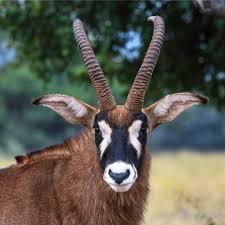
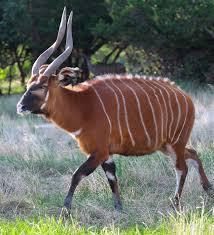
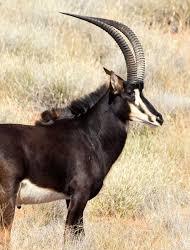
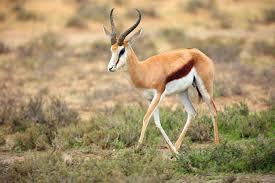
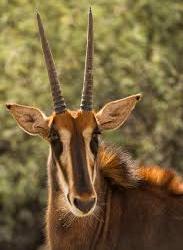
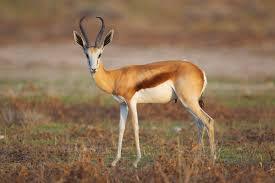
(Antelope overload)
Did you imagine a hoofed animal? Perhaps in grassy Africa? Grazing? Perchance, like the charming fellows above?
Well, all of the above are antelope! So what is 'antelope'? A family? An order even? No, and no, though, its related to a family in that it is a collection of genuses, but it's what's called a wastebasket taxon.
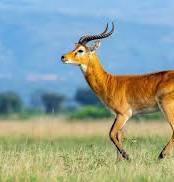
An antelope must be part of the family bovidae and NOT be a goat, sheep, or other cattle, the EXACT rules are a touch shaky because, well, antelope is (I believe) a polyphyletic grouping, meaning the group neither posses the common ancestor of all members of the group (which would be paraphyletic) or the common ancestor AND all descendents of that ancestor (which would be monophyletic, which makes something a true clade).
But there's still some meaning to the word, 91 entire species of antelope roam Africa, India, Central Asia, the Middle East, and even a small part of Eastern Europe.
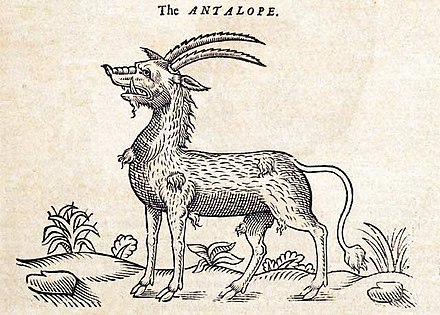
(Illustration from The History of Four-footed Beasts (1607))
In much of ye old Europe the antelope was strangely viewed as a mighty beast of prey, with horns of razor and the heart of a wolf.
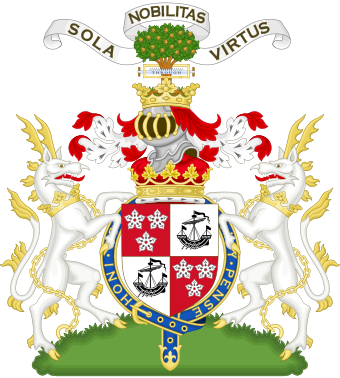
(Coat of arms of the Dule of Abercorn)
This design was used largely for heraldry, and still sticks around today, I think it looks neat.
Now, lets go over specific antelope, I've chosen based on very good reasons.
Best scientific name
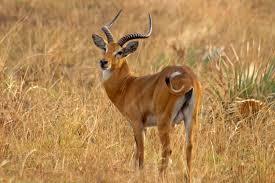
(A kob)
Some scientific names repeat themselves, such as Vulpes vulpes, those ones are easy to remember, some species names are used as a common name, such as Arcticitis binturong
Then you have...
THE KOBUS KOB, near perfection, the generic name is very similar to the species name, and the species name is also a major common name, tremendous bonus points because it sounds funny
Even more bonus points because there's a subspecies called the Kobus kob kob, perfection, no notes.
The littlest baby
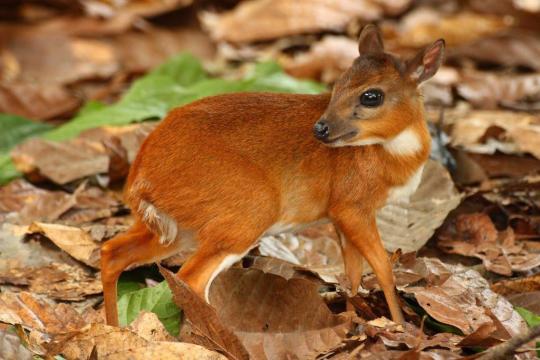
(So cute, squeeeee!)
The royal antelope, known scientifically as Neotragus pygmaeous, it's one of a large (unlike them, hehe) number of 'dwarf antelope' but the royal antelope is the littlest among them.
Standing up to 10 inches (25 cm) tall and weighing in at (at the upper end) 6.6 lb (3 kg), that footlong hotdog you had for lunch is longer than this lad is tall!
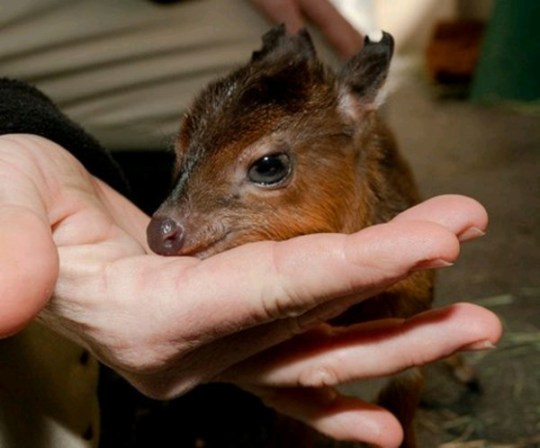
(A wittle baby royal antelope)
Little is known about these jungle-dwelling cuties, they mysteriously wander hidden in foliage.
The weirdest
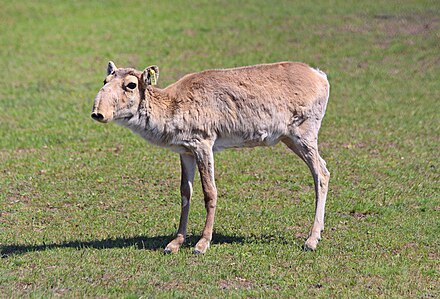
(Such a silly guy!)
The saiga (Saiga tatarica) I mean, just look at him! This antelope lives mostly in Russia, making it an oddity in geographic location too!
Their strange downward curved nose is mysterious, and seems to serve many purposes, keeping warm, filtering out dust they inhale, and, of course, an amazing sense of smell!
They even communicate with loud nasally roars!
The most antelope-y
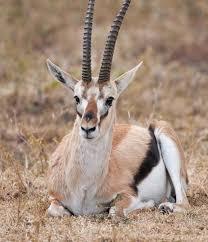
(Such antelope, much cute)
Thomson's gazelle (Eudorcas thomaonii) will always be the masoct of antelopes, the true antelope, to me.
It's still exceptional though, the fourth fastest land animal, running up to 50-55 MPH (80-90 KM/H) cheetahs (the fastest land animal) are their main predator. They're also sometimes called tommies!
The biggest baby
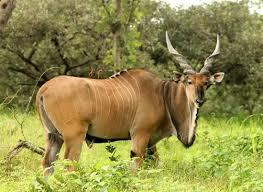
(They tall)
The fittingly names giant eland (Taurotragus derbianus)!
Standing between 7.19 and 9.55 feet (219 and 291 cm) tall, females weighing between 660 and 1320 pounds (300 a and 600 kg) and the larger males weighing from 880 up to 2650 pounds (400 to 1200 kg)!
My Favorite!
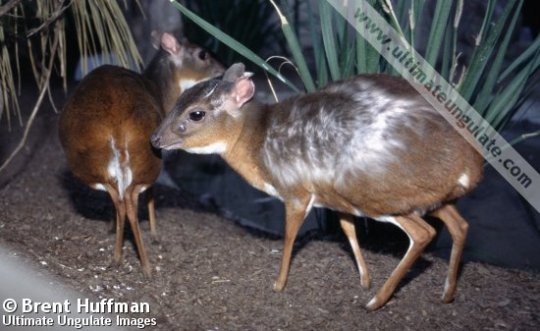
Yes, that's the royal antelope, it was love at first sight, okay? They're perfect! The saiga and Thomson's gazelle are the runner ups.
The most threatened
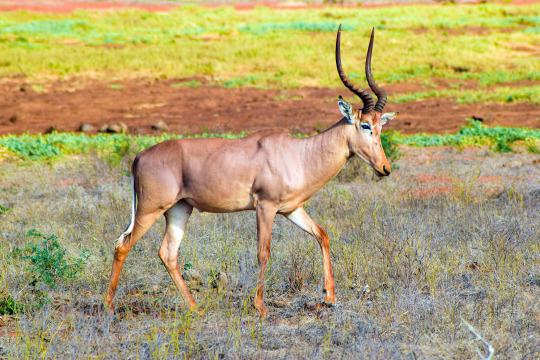
Sadly, there are several terribly threatened antelope, the hirola, or Beatragis hunteri is the worst off, considered critically endangered by the IUCN, there is only two levels worse than that, extinct in the wild, and truly extinct.
Less than 500 remain, none in captivity. Neither humanity nor nature have been too kind to this critter, hunting, habitat loss, disease and more have devestated this poor creature, the lowered elephant population causes bush enchroachment, harming the hirola, giving a good show of the domino effect of extinction, but its not all bad.
August twelth is hirola day! Human's have begun manually trimming brush, to keep the habitat of the hirola (and other species) in place, if they did go extinct it'd be the first time a mammalian genus has gone extinct in mainland Africa in modern human history, lets try not to lose the record we have going.
I have hope.
Sadly, the saiga is, yet again, a runner up, it too is critically endangered, along with other antelopes.
#TaxonOverview#animal facts#animals#cute animals#wild animal#animal photography#animal fact#antelope#Antelope facts#gazelle#zoology#Please point out any typos or erroneous information
4 notes
·
View notes
Note
is there a known point at which humans and pokemon diverged?
yes! i've been meaning to talk about something similar to this, so we'll be needing to expand the scope of this ask by, like, a lot. so, first we do kind of need to answer what a pokemon actually is, what it means when we say an organism is a pokemon. and to do that: i'm going to tell you about dinosaurs and trees. stick with me, here, i'm having fun. here's a little phylogeny lesson.
we'll be using dinosaurs as our example to talk about evolutionary relationships: dinosauria is a clade, also called a monophyletic group. that means that it is defined as one common ancestor and all its descendants. genera, families, and so on are usually clades (there are some exceptions, usually resulting from outdated definitions already being important and widely accepted before new data mixes up how we thought the family tree looked. for example, fish isn't a monophyletic group, because they exclude the tetrapods. if fish were a clade, we'd all be fish. as we should be).
here's a very, very simplified family tree of the archosaurs, the group that includes crocodiles, dinosaurs, and pterosaurs. think of this whole thing as a tree branch that splits and diverges as new species and groups arise.
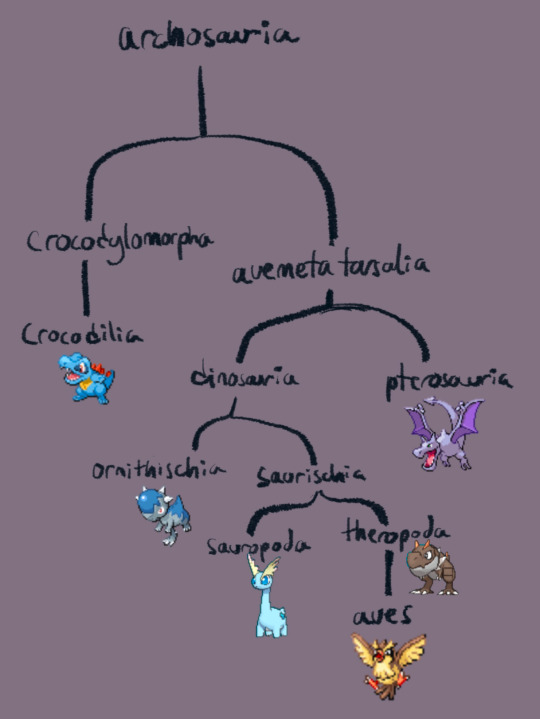
a monophyletic group, or clade, is like if you snip a branch from the tree and include the entire branch. so, if you snip this tree at the dinosauria branch, it'll have the ornithischia and saurischia (including sauropoda, theropoda, and aves) twigs on it, so all ornithischians and saurischians are dinosaurs. (in case you didn't know, birds are dinosaurs, and that's why!) basically, if it evolved from a dinosaur, it will also be a dinosaur.
(the next two terms are not actually relevant to our discussion, but if i'm defining monophyly, i need to tell you about the other two -phyly's, so bear with me. now, a lot of times when people say "dinosaurs", they don't mean to include birds- this is called a paraphyletic group. this means it excludes a part of the branch- so, if you snipped the tree at dinosauria, and then discarded the aves twig, you would have a paraphyletic group including ornithischia, sauropoda, and theropoda minus the aves.
the third common type of grouping is polyphyletic, which is when multiple branches of a tree are grouped together. so, if you snipped the tree at, say, crocodilia, pterosauria, and sauropoda and made those separate branches a group without anything else, that would be a polyphyletic grouping.)
.
now, let's look at trees. the word 'tree' doesn't describe an evolutionary grouping like the previous words do, 'tree' is just a descriptor that refers to how something looks, or what physical features it has- trees have woody stems, are perennial, and have branches with leaves, for example. there are species from all around the plant kingdom that are trees, that are entirely unrelated from one another! for example, an oak tree is much more closely related to a rose bush than it is to a pine tree. so "tree" is a morphological descriptor, not an evolutionary one.
now, what are pokemon? let's look at some of the traits every single pokemon shares. all pokemon have one or two out of the 18 types. they can all learn moves and have abilities, and can be caught in pokeballs. there is no one monophyletic group that includes all pokemon and excludes all non-pokemon. hell, there are things outside of the kingdom of life that are pokemon, look at trubbish. that's just a bag of trash that came to life. that's not related to literally anything. god i love trubbish
that is to say, pokemon is a morphological descriptor, just like trees, and not like dinosaurs. it is a group of things with particular characteristics with no regard to how they're related evolutionarily.
so, now we loop back to your original question: when did humans diverge from pokemon? in fact, humans evolved from organisms that were pokemon. almost every vertebrate is a pokemon, with the majority of the exceptions being tiny, so humans not being pokemon is pretty weird given we are Big Vertebrates, we're as far as we know the Only Big Vertebrate that isn't a pokemon.
our lineage lost its.. pokemon-ness right around half a million years ago. apologies if i get some specifics wrong here, human evolution isn't my forte- but the first non-pokemon human was Homo heidelbergensis. H. heidelbergensis gave rise to Homo neanderthalensis (commonly known as neanderthals) and Homo sapiens- that's us! every other member of the genus Homo, and the great apes more broadly, are pokemon. of the non-pokemon Homo lineage, Homo sapiens (us) is the only remaining species (though many people do have a fair bit of neanderthal heritage in there).
well, why did our little human lineage stop being pokemon? it's generally a pretty big advantage to be able to breathe fire, or shoot ice lasers, or use telekinesis or whatever, so there's a strong selective pressure against losing pokemon-ness, despite its high energy cost. well, as far as i know, the best theory we have for that has to do with our relationship with pokemon, and the fact that we're so good at becoming friends with them. seriously! ancient humans befriended and worked with the pokemon around them, so much so that they essentially lost the need to be pokemon themselves.
because most pokemon require much more energy than the average non-pokemon to function, due to the aforementioned fire breathing and ice lasers and such, if there's no strong selective pressure for a species to keep being a pokemon, that trait will generally be selected against. summed up: the reason you and i aren't pokemon is because we're friends with pokemon. :)
oh, and- our closest non-pokemon relatives are basically everything else in the genus Homo. that's the ralts line, sawk, throh, and yes, of course: mr. mime. so next time you're out training, be sure to say hi to your closest pokemon cousins.
whew! that was a longwinded answer for something that technically could've been, like, a paragraph, but thank you for reading my tangents if you did.
332 notes
·
View notes
Text
It Came From The Wastebasket #19: The Pterrible Fate Of Ptychopariida
The Ptychopariida were some of the earliest known trilobites, first appearing in the early Cambrian about 521 million years ago and surviving until the end of the Ordovician about 444 million years ago. They included some of the most numerous and common trilobite species, and were probably ancestral to multiple other major lineages – including the very last trilobites at the end of the Permian – making them incredibly important in understanding the overall evolution of trilobites as a whole.
…But this group is also one of the biggest wastebaskets in paleontology.
First established in the early 20th century, the ptychopariids seemed to have some fairly good defining characteristics based on their facial sutures, large thoraxes, and relatively small pygidia. But the group quickly became a dumping ground for a massive amount of Cambrian trilobites, eventually containing numerous different families, hundreds of genera, and many more individual species.
Actually figuring out their internal evolutionary relationships also turned out to be extremely difficult – so much so that some paleontologists working on them just gave up trying and arranged the genera names alphabetically instead!
Even cladistic studies from the 1970s onward struggled to make sense of these highly "problematic" trilobites, and any larger-scale analysis was a daunting task due to how huge and diverse the ptychopariid wastebasket had become over the years. Worse, some of the anatomical features the group had been based around were starting to look more like the result of a lot of convergent evolution across multiple lineages than any actual shared ancestry.
Efforts were still made at breaking up the mess, however, with better-understood sub-groups like the Proetida, Harpida, Asaphida, Trinucleida, and Olenida being gradually split off into their own separate orders over the course of the last few decades.

Ptychoparia striata
But even by the early 2010s what remained of the Ptychopariida was still paraphyletic at best, more of an "evolutionary grade" of early trilobites than a single lineage, with most of its constituent families also rather poorly defined. There was even a proposal to abandon the group entirely, stating that "it serves no scientific purpose" and that its orphaned contents should be considered "order uncertain" until their actual relationships can be untangled.
Today the "ptychopariids" are in dire need of a full revision – since they were the ancestors of many other major groups they're still crucial for understanding early trilobite evolution. There may be a salvageable single lineage somewhere in the remains of this wastebasket, even if it's restricted to just close relatives of the genus Ptychoparia, but until somebody tackles them properly they're stuck in taxonomic limbo with their name only being used in a loose sense.
———
Nix Illustration | Tumblr | Twitter | Patreon
#it came from the wastebasket#wastebasket taxon#taxonomy#ptychoparia#ptychopariida#trilobite#arthropod#invertebrate#paleontology#art#science illustration#paleoart#palaeoblr
132 notes
·
View notes
Note
🧬🦕
Is it cool if I get a little personal? Let me tell you about one of the coolest things I've ever gotten to do: two summers ago, I got to see the Archaeopteryx fossil at the Wyoming Dinosaur Center, which is also the only specimen on display in North America.
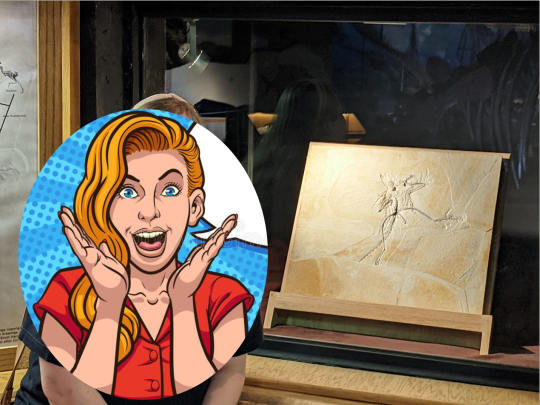
Trust me when I say that the stock clip art that I chose to obscure myself is 100% representative of the face I'm making here. If anything, the smile isn't big or goofy enough.
Here's a close-up and a diagram to show up-close what I'm actually looking at. Note the impressions of wing and tail plumage!


Diagram source
You've probably at least heard of Archaeopteryx: it's a transitional genus dating to the late Jurassic and the earliest example of what we could consider a "bird" which retains many ancestral "reptilian/dinosaur" characteristics.
Now, "bird" and "reptile" are kind of arbitrary words here because reptiles are a paraphyletic group. DNA tree-building models and sequence alignment evidence demonstrate that there's simply no way to define "reptiles" which does not also include birds; the definition of a "reptile" is a sauropsid that is not a bird. Thus, we know that all birds have a reptilian common ancestor because they arose as a branch within the sauropsid clade. Archaeopteryx is an ancient sauropsid with both avian and reptilian features; this is what we mean when we call it a transitional genus.
But why did this transitional fossil make me smile so big that my cheeks went numb? There are several reasons, I think:
Despite its transitional characteristics, most scientists consider Archaeopteryx the first bird in the fossil record. It was also the first direct evidence that birds evolved from reptilians (the first Archaeopteryx specimen was discovered just three years after On the Origin of Species was published). Just on a basic, fundamental level, this genus is of immense scientific and historical importance and standing next to it felt like meeting a celebrity.
The particular specimen that I got to see was super cool! Unlike most Archaeopteryx fossils, which tend to be preserved on their sides, this one is preserved on its stomach with its head in three-quarter view. Thus, it's the only specimen in which the palate bones are clearly visible, and it's tetraradiate (as in non-avian theropods) rather than triradiate (as in other avians.) The palate is one of the most important features in terms of saying, "yeah, we consider this a modern bird."
Its feet are also really well-preserved! The specimen I saw clearly demonstrates that Archaeopteryx didn't have a reversed toe, but does have a hyperextendable second toe. This means that unlike modern birds, it probably had limited ability to perch; instead, it had tearing claws like a dinosaur.
But even in contrast with other important transitional fossils - say, the Archeoceti of Wadi al Hitan in Egypt, which are amphibious ancestors of modern whales - Archaeopteryx is something special. There's a certain romance to the idea of the first bird: feathers that actually enable something like flight! (Like Buzz Lightyear, Archaeopteryxes' wings were probably used for "falling with style.") But still, there's beauty in Archeopteryx that we don’t see in other transitional fossils. In his poem "The Archeopteryx's Song," Edwin Morgan captures this glory far better than I ever could:
I am only half out of this rock of scales.
What good is armour when you want to fly?
My tail is like a stony pedestal
and not a rudder. If I sit back on it
I sniff winds, clouds, rains, fogs where
I'd be, where I'd be flying, be flying high.
Dinosaurs are spicks and
all I see when I look back
is tardy turdy bonehead swamps
whose scruples are dumb tons.
Damnable plates and plaques
can't even keep out ticks.
They think when they make the ground thunder
as they lumber for a horn-lock or a rut
that someone is afraid, that everyone is afraid,
but no one is afraid. The lords of creation
are in my mate's next egg's next egg's next egg,
stegosaur. It's feathers I need, more feathers
for the life to come. And these iron teeth
I want away, and a smooth beak
to cut the air. And these claws
on my wings, what use are they
except to drag me down, do you imagine
I am ever going to crawl again?
When I first left the crag
and flapped low and heavy over the ravine
I saw past present and future
like a dying tyrannosaur
and skimmed it with a hiss.
I will teach my sons and daughters to live
on mist and fire and fly to the stars.
And like, that’s it, right? Obviously no Archaeopteryx could possibly have any concept of bird or dinosaur. No fifteen million year-old creature could have dreamed eagles or pigeons or penguins. But God did.
God knew from eternity that a creature called Archaeopteryx would exist. He knew that it would have a dinosaur’s sharp teeth and bony tail and yet wings and feathers to glide with. He alone could imagine a world in which creatures sharing a close relative with Archaeopteryx would have more feathers for the life to come; that the lords of the skies would be in the next egg’s next egg’s next egg.
He knew that Jesus would tell his disciples to look at birds when they were worried; that Gerard Manley Hopkins would write a poem dedicated “To Christ our Lord” in which he extolled “My heart in hiding/ Stirred for a bird, – the achieve of, the mastery of the thing!” God knew that the albatross, so like and yet unlike Archaeopteryx, would live its life on the wing, flying over oceans ten thousand miles at a time, and that Samuel Taylor Coleridge (a devout Christian) would write a poem in which an albatross was Christlike, and that C.S. Lewis would write a book in which an albatross was Jesus and whispered courage to a little girl in the dark. God knew that one day, in the summer of 2021, I would stand beside this fossilized evidence that Archaeopteryx really lived, staring and squinting to see all its features, grinning like an idiot and thinking, “Do you imagine I am ever going to crawl again?”
#i'm legit tearing up#i think i've gotten well away from the concept of 'fun fact' i'll reign it in a little for the next one#i love you archeaopteryx#ask me hard questions#all truth is god's truth#dinosaurs make me happy#fossils! dun dun dun
9 notes
·
View notes
Text
Clade Vertebrata minus Clade Stegocephali. Easy. It's a definition, not a clade.
The (slightly) more tricky part is where both a clade definition and a non-clade definition are interesting, like "reptile".
Do we take it as the smallest crown group containing Eureptilia and Parareptilia? (Which, given that either might be horribly paraphyletic to the other, might just be "the largest of the two")
Do we take it as a synonym for Sauropsida, with either its crown group or stem group definition?
Or do we explicitly define it as a paraphyletic group of "sauropsids excluding birds", which is a bit sad because it hides all the similarities birds have with their relatives (especially archosaurs) and perpetuates false relationships (e.g. crocodiles being grouped with "cold-blooded" reptiles, despite their cold-bloodedness being a separate recent development)
as funny as it is to say, "theres's no such thing as a fish" is not actually true
"science doesn't know what a fish is" is really not true
"fish" is not a monophyletic category. there is no common ancestor of everything that we call a "fish," and none of the things that we don't
"fish" is a paraphyletic category -- and a useful one! marine biologists use it! "fish" describes a general body plan and lifestyle. it is useful to be able to talk about coelacanths and tuna in a shared category, though coelacanths are more closely related to us than to tuna.
where this bugs me is the repetition of the idea that "scientists" are hidebound and uncreative, unable to comprehend anything that doesn't conform to a specific idea of categorization -- when this is fundamentally untrue! we know perfectly well what a "fish" is. the fact that it's a paraphyletic group is only confounding to pop science, as a funny factoid, not to anyone who actually understands what a paraphyletic group is.
9K notes
·
View notes
Text
Alright listen up nerds I want you all to read ALL OF THE FOLLOWING before commenting. I’m not in the mood to have the taxonomy police come to my door and arrest me for taxa crimes.
1. The contents of this video is an adaptation of the cladogram below into a new type of phylogeny that (I’m pretty sure) I created.

2. Yes I know that this is an outdated phylogeny. This is a phylogeny that I drew in my notes in a class I took a while back. My professor was older. Older professors tend to teach the phylogenies that they learned. I take the notes even if they are inaccurate because they test me on it and I just want the grade. I chose it because it is easy enough for me to read, and I wanted something that I could understand so I can do the mad scientist experiment I’m doing now. Also I’m ignoring strepsiptera because idk what’s going on w them.
3. The following are the rules for how to read my phylogeny.
This phylogeny is to be thought of as if it is a Venn diagram. This means that there are categories within categories. If circle B is inside circle A, that does not mean B stops being A, it means that B is a type of A. Unlike a Venn diagram though, the circles never overlap.
Each circle is a monophyletic group. Since circles cannot overlap, that means paraphyletic groups are impossible and can never be named.
If circle B is inside circle A, this means B is the descendent of A, and A is the ancestor of B. These ancestors might not have names. For example, Pterygota is the clade that designates winged insects. But the first insects to evolve wings were probably not called the “order pterygota” if that makes sense. They are unnamed in the phylogeny. Untitled circles are also unnamed.
If a circle has multiple circles inside of it, that means those circles are sister taxa.
The colors do not mean anything. They are there to make it easier to read.
4. Why did I do this? What is different here if both phylogenies contain the exact same information?
The answer is 1) on where the emphasis is placed and 2) I wanted to eliminate the concept of paraphyla and leave only monophyla.
On a cladogram, the emphasis is placed on the divergence of clades. It is placed on how the descendent has changed from the ancestor in a way that makes it look like it has become an entirely new group. I am not fond of this.
On my phylogeny, the emphasis is placed on how even though the descendent has changed from its ancestor, it does not fall outside of the ancestor’s group.
Now onto the topic of monophyletic groups and paraphyletic groups. A monophyletic group is a group that contains organisms that share a common ancestor. A paraphyletic group is a group that contains the descendants of a common ancestor, but excludes some of the descendants of that ancestor as well. For you visual learners out there, here is an example from Wikipedia.

The blue group is a monophyletic group because every descendent of that branch is included. The blue and green group put together are a monophyletic group because every descendant of that branch is included.
The green group by itself is a paraphyletic group because it excludes the blue group. Not every descendent of the green group’s ancestor is included.
Why do I have a problem with paraphyla? I find them to be arbitrary and therefore not really useful. If birds are dinosaurs, and dinosaurs are reptiles, then why do we need to exclude birds from reptiles? I gain 0 amount of information from separating them, but I learn much more when they are included. This doesn’t mean you need to erase birds as a clade, it just means that birds are a type of reptile. Excluding them seems arbitrary to me. This paragraph just represents my own opinion. You are free to disagree, but I find that giving names only to monophyla keep things much more clear, concise, and consistent.
And now I must ask you, does this make sense? Are there any glaring issues I have missed? What are the pros and cons of each paraphyletic system, because mine sure isn’t flawless, but I want to see if you can spot any of the same ones that I did. Anyways thanks for reading my brain dump. You guys are cool.
#I imagine that the feeling I’m getting from posting this is the same feeling I would get if I ever posted n udes#like wow I am really letting y’all judge my dumb ideas like this#have fun but please don’t hurt me ^^;
59 notes
·
View notes
Text
Friday 23/7/21 - Stem-Birds and Derived Fish
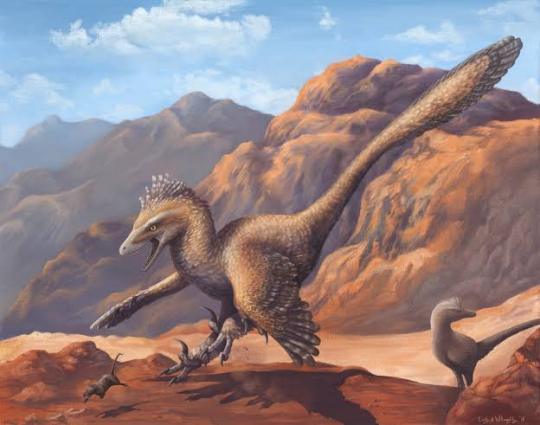
Velociraptor, a stem-bird and a derived fish, Emily Willoughby
Phylogeny is a term used to describe the study of evolutionary history of various living things. You may have seen as a younger student that evolution could be described as a straight line leading to what we have today, but the truth is the tree of life twists and divides, and human beings are only just the latest thing on our specific branch.
When discussing how things are related to one another, there are various terms you can use to bracket related groups together, and because a lot of these terms are vague, you can get really creative with how wide you make the brackets.
The two terms I wanna discuss today are "stem" and "derived". If something is a stem-group, that means it branched off the tree of life earlier, and shares older ancestors with the focus group. If something is derived, that means that it is closer to the end of its specific branch on the evolutionary tree of life.
Let's use some examples.
Stem-Birds
Confusciornis is what scientists describe as a stem-bird. It is part of a group called the Avialans, which are all dinosaurs closer related to sparrows than to dromeosaurs. Confusciornis was not a true bird, it still had teeth in its beak, and clawed wings.
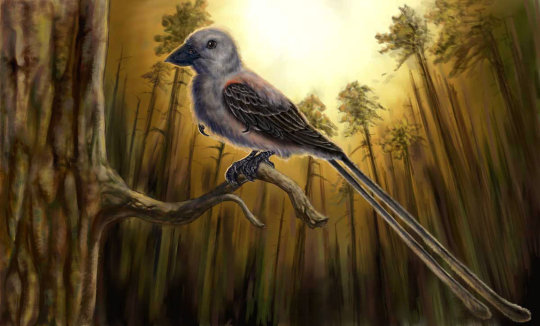
Confusciornis, Kevin Yan
It is a stem-bird, because in tree terms, it is closer to the trunk than to the actual branch birds were on. But we don't need to be that exclusive with our definitions.
If stem-birds refers to something thats almost a bird, let's broaden that to include the raptors. Velociraptor is a stem-bird, they shared a common ancestor. Tyrannosaurus was a stem-bird, and although it is further up the tree, they branched off fairly recently in evolutionary terms.

A group of loosely related Stem-birds, Douglas Henderson
And if we get silly with it enough, Diplodocus was a stem-bird, since Sauropods are closer related to birds than they were to most plant eating dinosaurs. You could keep going and say Pterodactylus was a stem-bird, but if you wanna be serious, most scientists stop the definition at dromeosaurs. But that's what happens when phylogeny is vague enough.
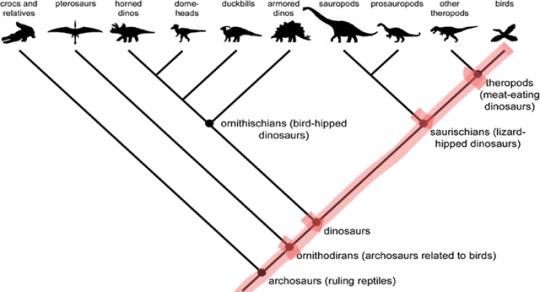
Archosaur Phylogenetic Tree; the red line representing the line leading to birds. If the definition is vague enough, anything branching from the line could technically be a stem-bird.
Derived Fish
Theres this issue with Phylogenetic Bracketing, (giving a name to a group of related organisms) where a lot of names for animal groups do not include all descendants. Clades (a group of living things) can be monophyletic, paraphyletic, or polyphyletic.

I'll give simple examples here. Birds are a monophyletic group. Everything we call a bird shares a common ancestor. Fish are a paraphyletic group. There are some things derived from Fish, e.g. amphibians, that we don't call fish. Worms are a polyphyletic group, because the worm body plan came from many different groups and many aren't even remotely closely related.
Back to "derived" now. We don't have to adhere strictly to every clade rule, because we can use the word "derived" to describe groups outside a paraphyletic bracket.

Cladogram of all land vertebrates, Reptiles highlighted by the green circle.
The term reptile is often used to group snakes, lizards, crocodiles, turtles, and sometimes dinosaurs. But often, birds are left out of that group. We can say that birds are derived (advanced) dinosaurs, and therefore derived reptiles.

Tiktaliik, Liam Elward
As mentioned above, fish is a potentially ridiculously huge clade because every animal with a back bone is descended from fish. Tiktaliik was a very derived lobe-finned fish, related to coelacanths and lung-fish, and scientists think that animals related to Tiktaliik led to land animals with four legs, the tetrapods. So let's see how far we can stretch this definition of derived fish...
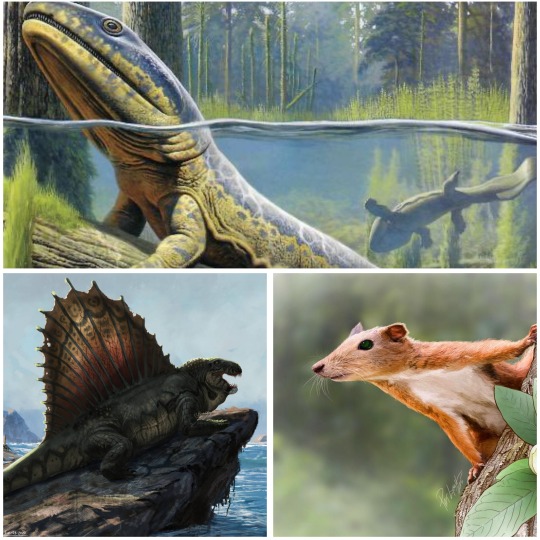
Acanthostega, Raúl Martín; Dimetrodon, Highdarktemplar (deviantart); Purgatorius, Patrick Lynch
Acanthostega was an early amphibeon descended from Tiktaliik or its relatives. So let's say that amphibians are derived fish. Amphibians gave rise to early mammal relatives such as Dimetrodon. So stem-mammals are derived fish. Mammals evolved during the time of the dinosaurs, and had split into the beginnings of modern groups at the time; Purgatorius was a stem-primate that lived at the same time as Tyrannosaurs. So primates are derived-fish. And why not make the final leap. Primates gave rise to the current dominant species on Earth, Homo sapiens.
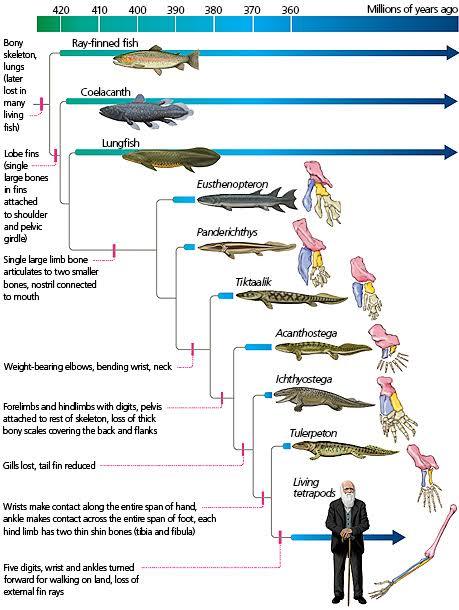
Fish Phylogenetic Tree
Humans are derived fish.
Phylogeny is vague and can get very silly.
145 notes
·
View notes
Photo
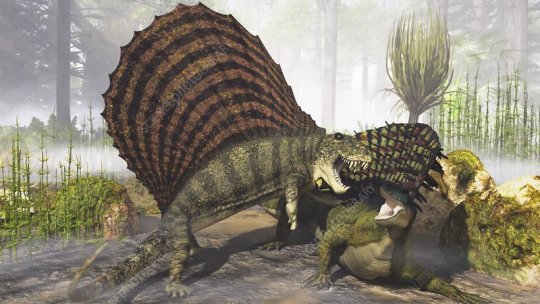
The caption “Illustration of the pelycosaur dinosaurs Dimetrodon grandis (left) and Edaphosaurus progonias (right) battling during the Permian period in what is now North America.” is incorrect.
Doing a search for “Dimetrodon vs Edaphosaurs” just now lead to this stock illustration from this page.
Science Photo Library hosts stock photography and illustration for professional graphics use. A valuable resource, but every now and then the captions for its illustrations have errors. In this case, both Dimetrodon and Edaphosaurus are are correctly identified as pelycosaurs (as that label is traditionally used), though distantly related despite both sporting dorsal sails (a trait each developed independently of the other). However pelycosaurs are not a subgroup of dinosaurs! They are, as traditionally viewed, primitive mammal-like reptlies. In cladistics though, “Pelycosauria” is a paraphyletic grouping, meaning that it includes some but not all of the taxa that are closely related to the basal members. All pelycosaurs, however, are members of the Synapsida, the clade of tetrapods (fully terrestrial vertebrates) that include mammals, and by extension, humans. They are more closely related to us than to dinosaurs.
So, to repeat, Dimetrodon and Edaphossaurus are not dinosaurs. They are classified in the synapsid lineage that we belong to, rather than the reptile lineage that dinosaurs, birds, and crocodiles belong to.
10 notes
·
View notes
Text
Foraminifera: Introduction and anatomy
There’s a lot more to palaeontology than just dinosaurs. I’m sure you’re familiar with fossil mammals like mammoths and sabre-tooths. Everyone loves fossil fish like Dunkleosteus and Megalodon. Fossil invertebrates, like trilobites or ammonites, are some of the most famous fossils of all time. And fossil plants are all over the place, from petrified wood to leaf impressions in coal. But have you ever thought about fossil microorganisms?

(Image: Single-celled organisms like this foraminifera are among the most common organisms today, but the vast majority are microscopically small. [Source])
Microbes are everywhere on Earth today, and they have been everywhere on Earth for seemingly as long as life has existed. They live in practically every environment—but their small size and soft bodies have meant that fossils of them are very rare.
Well, almost all of them, that is. One particular group of single-celled organisms is among the best-studied groups in the entire fossil record, having a highly detailed fossil record stretching back for over 540 million years. These are the hard-shelled foraminifera.
I’ve become enamoured with this neat little group of protists lately. But I’ve been really disappointed with a lot that’s been written about them. For despite being some of the most interesting and geologically famous protists, there has been very little written about them that is accessible to anyone who doesn’t already know a lot about them. I’d like to change that.
What are foraminifera?
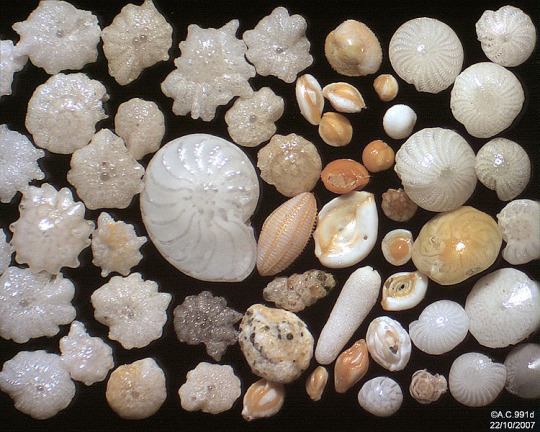
(Image: An assortment of foraminifera shells, with a huge variety of shapes and sizes. More on that later... [Source])
Foraminifera (literally meaning “opening bearers”), or “forams” as they are commonly called, are a group of single-celled eukaryotes. In other words, they have a nucleus (or often multiple of them), and they have mitochondria that act as (say it with me) the powerhouse of the cell. Most forams consume smaller microorganisms as food; however, some are capable of utilising dissolved organic carbon, and many groups have convergently evolved endosymbiotic relationships with photosynthetic algae, including rhodophytes, chlorophytes, and dinoflagellates. In fact, certain foraminifera can extract the chloroplasts from algae they consume and incorporate them into their own cells to do photosynthesis! These don’t last forever, though, and the forams eventually digest the chloroplasts. Some other foraminifera actually actively predate on and kill small animals—an amazing feat for a single-celled organism!
Some of the most famous foraminifera are the planktonic forms that float within the water column; however, the vast majority of forams are benthic organisms. These include forms from shallow water to forms found at the very deepest point of the ocean. Though some benthic species live only above the sediment-water interface and others live only interstitially, most benthic forams are not confined to one mode of life and may move between layers of the community in order to seek out food. Some of these forms can even survive without oxygen for extended periods! This allows them to live in conditions that would kill many other organisms.
A few species of forams have been identified from freshwater environments, and one study presented molecular evidence suggesting foraminifera may be widespread in soils, although no actual forams have been found from soils yet. It seems that there might be a lot of diversity even among living forams that we still have yet to uncover.
Anatomy
Of all single-celled organisms, why is it that foraminifera have such a good fossil record? The answer lies in the hard shell of many species, known as a test.
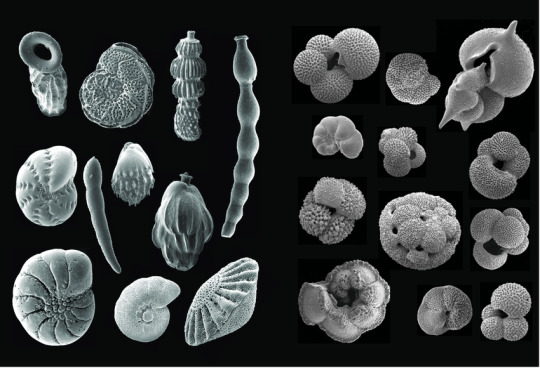
(Image: A variety of test shapes in different foraminifera groups, viewed with a scanning electron microscope. They include may shapes—coiled, glob-shaped, linear, egglike, and more. There are many other shapes of tests that aren’t shown here—like spiralled, branched, disc-like, and more. All of these tests are calcareous. [Source])
These tests are not simply external structures within which foraminifera live; rather, the test is actually within the cell membrane. Although the soft parts of the foraminiferal cell are almost never preserved in the fossil record, modern species of forams have helped us learn a lot about their anatomy. Extending from the opening(s) of the test are pseudopodia, fingerlike extensions of the cell membrane. As the most prominent extensions of the cell outside of the test, they serve a multitude of functions, including locomotion, feeding, agglutinating the test, reproduction, respiration, and excretion. In many forms these pseudopodia extend in all directions through numerous tiny holes in the shell of the test. In other ways the foraminifera anatomically resemble typical single-celled eukaryotes, with nuclei and mitochondria. Some species have multiple nuclei within a single cell). During reproduction, some species of forams can even leave their shell behind entirely to undergo cell division.
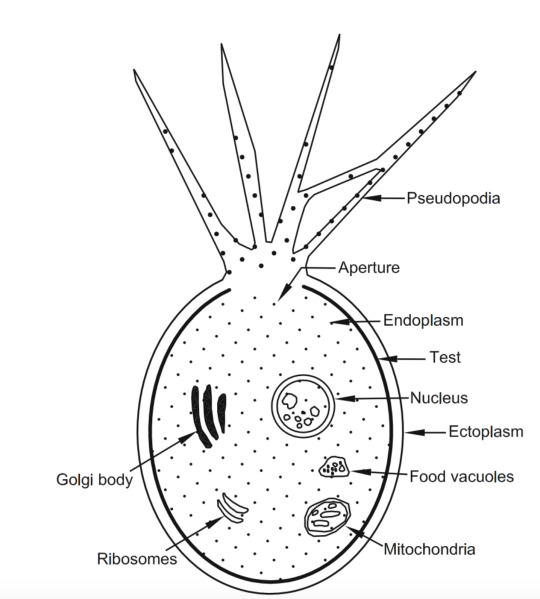
(Image: The anatomy of a foraminiferan. Note that the test is actually inside of the cell wall, but most of the cell materials are inside the test. The pseudopodia are the main thing that extend out of the aperture, or hole. This drawing is a unilocular, or single-chambered, foram.)
The most famous and diverse of these are foraminifera with calcareous tests. Calcareous means that they are made of calcium carbonate, and calcium carbonate takes two main forms: Calcite and aragonite. Calcite is a very common mineral in nature; it’s the stuff that makes up limestone, marble, antacids, coral skeletons, and more. And aragonite is a mineral with the same chemical composition as calcite, but with a different crystal structure. It’s found in the shells of many organisms, like snails. Both calcite and aragonite tests are found in foraminifera, and many species have their own particular composition and crystal structure.
Other forams have agglutinated tests: that is, tests that are made by collecting bits of sand and cementing them together, using either organic proteins or calcite to hold them together.
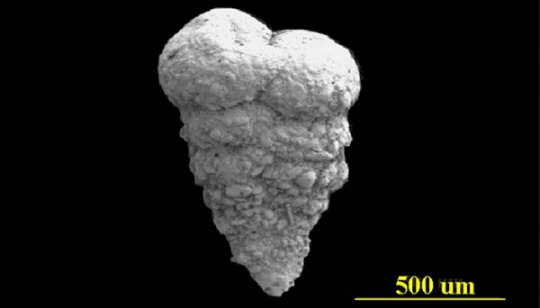
(Image: An agglutinated textulariid foram. Its test is made from sediment grains connected together. It looks a bit like an ice cream cone in shape, but rather than conical, it’s flat. And the top is sealed off. So really, it looks nothing like an ice cream cone. [Source])
Fewer still forams secrete tests of silica—the material that quartz and glass are made of. Others have softer tests made completely from proteins and other organic material. Even rarer are foraminifera which entirely lack tests and were until recently considered to be amoebae; these species likely secondarily lost the test.
Test composition appears to be pretty fluid in foram evolution. In the family tree of foraminifera, it seems that calcite tests evolved multiple times, and so did agglutinated tests. In some cases it looks like they might have even gone from calcite tests to agglutinated tests.
Test shape is also highly diverse within foraminifera. The simplest shape of test are the unilocular, or single-chambered, forms; however, unilocular forms may also have more complex chamber shapes, including spiraled tubes outwardly resembling snail shells. Unilocular forms are found in several groups of forams. The earliest foraminifera were probably all unilocular, and modern unilocular forams probably form a paraphyletic “grade” rather than a true branch of the tree of life. Single-chambered foraminifera probably make up the bulk of forams alive today, but many of these species remained undiscovered and unnamed.
Although unilocular forams are frequently considered the “simplest” forams, they also include some of the most bizarre protists, the xenophyophores. These are my favourite group of foraminifera, and the reason is, I think, pretty clear—they’re enormous. Like, I mean, the largest ones can get up to 20cm/8in across! These are the largest known single-celled organisms on the planet. All of the known species live on the floor of the deep ocean, where they filter-feed.

(Image: A xenophyophore, a giant, single-celled foraminifera. It looks a bit like a sponge, which is what it was once mistaken for. [Source])
Most named species of forams, however, are multilocular, having multiple chambers within their tests. The tests of the most well-known forms superficially resemble the shells of ammonites or nautili. In fact, the earliest scientific descriptions of foraminifera described them as being tiny cephalopods! The septa (internal dividing walls) of foraminiferal tests have holes that allow for the cytoplasm to flow between compartments, so that the cell can make use of all of the available space within the test. These openings—or foramina—also provided the name for the group: When initially thought to be cephalopods, they could be distinguished from all other coiled forms by the foramina between compartments.
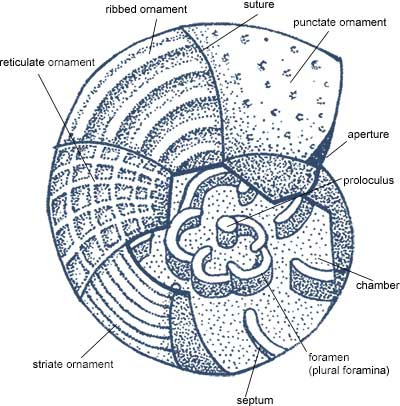
(Image: Cross-sectional diagram of a coiled, multichambered foraminifera. It does look a lot like a nautilus, and even has multiple chambers in its shell. However, unlike nautili, these chambers are connected by holes. [Source])
Not all multilocular foraminifera are coiled, however; many form more linear or globular shapes. Some are even star-shaped! Giants in their own right are found among the multilocular forms: the rotaliid genus Nummulites, though now smaller, has extinct representatives that could reach 15cm across, with up to 4300 distinct compartments. These lens-shaped forams make up the limestone that was used to build the Great Pyramids in Giza.
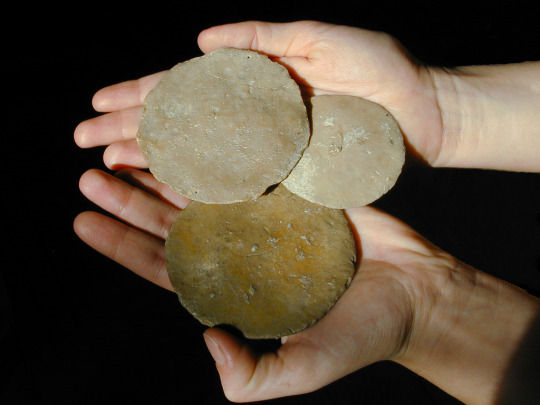
(Image: Fossil Nummulites shells being held by a human. They kind of look like pancakes, and are about 15cm/6in in diametre. Though you can’t see it here, they are actually coiled shells. [Source])
This post is the first in a multi-part series covering foraminifera—their anatomy, reproduction, evolutionary history, major groups, and geological applications. Later parts will be linked here, or check the “Foraminifera” tag on my blog!
#palaeontology#palaeoblr#foraminifera#biology#marine biology#microbiology#protists#long post#sunday long posts
273 notes
·
View notes
Text
Nothosaurus
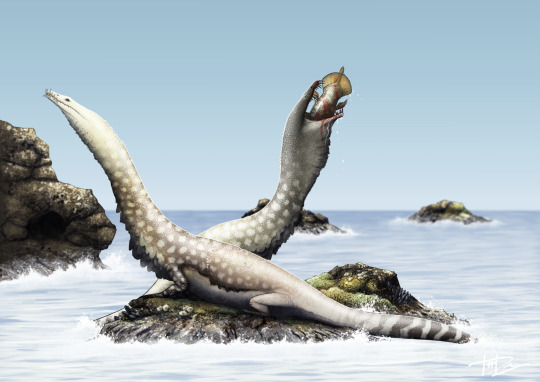
By Tas Dixon
Etymology: False Reptile
First Described By: Münster, 1834
Classification: Biota, Archaea, Proteoarchaeota, Asgardarchaeota, Eukaryota, Neokaryota, Scotokaryota, Opimoda, Podiata, Amorphea, Obazoa, Opisthokonta, Holozoa, Filozoa, Choanozoa, Animalia, Eumetazoa, Parahoxozoa, Bilateria, Nephrozoa, Deuterostomia, Chordata, Olfactores, Vertebrata, Craniata, Gnathostomata, Eugnathostomata, Osteichthyes, Sarcopterygii, Rhipidistia, Tetrapodomorpha, Eotetrapodiformes, Elpistostegalia, Stegocephalia, Tetrapoda, Reptiliomorpha, Amniota, Sauropsida, Eureptilia, Romeriida, Diapsida, Neodiapsida, Sauria, Archosauromorpha?, Archelosauria, Pantestudines, Sauropterygia, Eosauropterygia, Nothosauria, Nothosauridae, Nothosaurinae
Referred Species: N. mirabilis, N. cristatus, N. cymatosauroides, N. edingerae, N. giganteus, N. haasi, N. jagisteus, N. marchicus, N. mirabilis, N. tchernovi, N. yangjuanensis, N. zhangi
Time and Place: From 242 million years ago until 208 million years ago, from the Ladinian of the Middle Triassic through the earliest Rhaetian of the Late Triassic
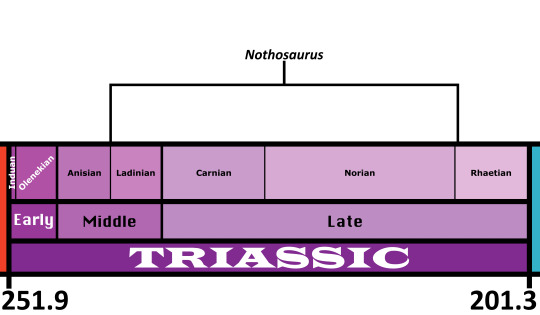
Nothosaurus is known from all over Eurasia and North Africa, to the point that it’s pointless to list all the locations. Just assume that if it’s the Mid or Late Triassic of the Tethys Sea, Nothosaurus is there.
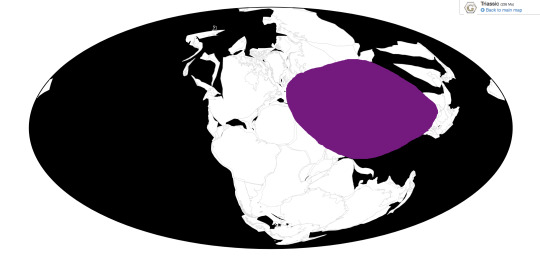
Physical Description: Nothosaurus is an iconic Triassic marine reptile - to the point that we had to include it, or else we would have violated some sort of rule of paleontology. Nothosaurus was about 4 meters long on average, but could reach up to 7 meters in length. It had a long, streamlined body, with a long neck and a long tail. Its head was narrow and filled with long and pointed teeth which interlocked together when the mouth closed, forming a tight trap. Its forelimbs were longer than its hind limbs, and all of its hands and feet had webbing between the long toes. In a lot of ways, it looked extremely similar to later marine reptiles to which it was closely related, like the Plesiosaurs and Pliosaurs, just with hands instead of proper flippers - however, current evidence indicates that the Plesiosaurs and Pliosaurs evolved from an ancestor of both groups, and Nothosaurus is just a Triassic offshoot. It had capabilities for diving in the water, though it also was still adapted for life on the shore.
Diet: Nothosaurus primarily ate fish and other marine animals, including other marine reptiles.
Behavior: Nothosaurus was semi-aquatic, spending a lot of its time both in the ocean and on land. On the beaches and shores it would rest and sleep, and then turn to the ocean for most of its everyday life. Diving for food would have been most of its daily activities, going after juvenile reptiles and large fish in the water and diving in order to reach it. It probably would have paddled with its webbed feet, and undulated its body to some extent to help propel forward. It may have been at least somewhat social, living in groups and colonizing the shores together before going for group dives for food. Interestingly enough, Nothosaurus was basically like a reptilian seal, coming up to shore to rest and sit with its relatives. Whether or not they would have given birth to live young is uncertain; while their close relatives, the Plesiosaurs, did; they retained enough land adaptations to allow them to lay eggs on the shore. More research as to their physiology is needed in order to determine that aspect of their life history. Trackways have been attributed to Nothosaurus, which may show that they rowed their paddles on the sea bed to shake up small animals trapped underneath; this would have allowed Nothosaurus to capture the invertebrates between its long teeth and hold onto them so they could not escape.
Ecosystem: Nothosaurus lived throughout the early Tethys sea, and was a common feature in many communities throughout this growing body of water during the Middle and Late Triassic. It would have stuck to the coasts for the most part, but still ventured out into deep and open water. As such, it’s rather difficult to list all the different animals it lived alongside - it’s found in Bulgaria, China, France, Germany, Hungary, Israel, Italy, Jordan, the Netherlands, Poland, Saudi Arabia, Spain, and Switzerland. So just, assume that a marine creature from the Tethys during this time lived with Nothosaurus rather than not.
Other: Nothosaurus has been treated as, unfortunately, a wastebasket taxon - it was discovered early enough in the history of paleontology as a science that many similar animals were just dumped into this name without any specific studies done. So, determining the factual relationships from this mess is still being worked out; in fact, it seems that this genus is paraphyletic, with many close relatives of Nothosaurus being more closely related to some species than to others. So that’s fun!
Species Differences: The varying species of Nothosaurus tend to differ based on where and when they lived, rather than any particularly notable differences. There are some differences in size and limb proportions as well, but in general the differing species of Nothosaurus would have had very similar ecological roles.
~ By Meig Dickson
Sources Under the Cut
Albers, P. C. H., and O. Rieppel. 2003. A new species of the sauropterygian genus Nothosaurus from the Lower Muschelkalk of Winterswijk, The Netherlands. Journal of Paleontology 77(4):738-744.
Albers, P. C. H. 2005. A new specimen of Nothosaurus marchicus with features that relate the taxon to Nothosaurus winterswijkensis. Vertebrate Palaeontology 3 (1): 1- 7.
Brotzen, F. 1956. Stratigraphical studies on the Triassic vertebrate fossils from Wadi Raman, Israel. Arkiv foer Mineralogi och Geologi 2(9):191-217.
Chrzastek, A. 2008. Vertebrate remains from the Lower Muschelkalk of Raciborowice Górne (North-Sudetic Basin, SW Poland). Geological Quarterly 52:225-238.
Diedrich, C. 2009. The vertebrates of the Anisian/Ladinian boundary (Middle Triassic) from Bissendorf (NW Germany) and their contribution to the anatomy, palaeoecology, and palaeobiogeography of the Germanic Basin reptiles. Palaeogeography, Palaeoclimatology, Palaeoecology 273 (1): 1 - 16.
d'Orbigny, A. 1849. Cours Élémentaire de Paléontologie et de Géologie Stratigraphiques [Elementary Course in Paleontology and Stratigraphic Geology] 1:1-299.
Haas, G 1980. Ein Nothosaurier-Schädel aus dem Muschelkalk des Wadi Ramon (Negev, Israel). Annalen des Naturhistorischen Museums in Wien 83:119-125.
Haines, Tim, and Paul Chambers. The Complete Guide to Prehistoric Life. Pg. 64. Canada: Firefly Books Ltd., 2006
Hinz, J. K., A. T. Matzke, and H.-U. Pfretzschner. 2019. A new nothosaur (Sauropterygia) from the Ladinian of Vellberg-Eschenau, southern Germany. Journal of Vertebrate Paleontology.
Jiang, W.; Maisch, M. W.; Hao, W.; Sun, Y.; Sun, Z. 2006. Nothosaurus yangjuanensis n. sp. (Reptilia, Sauropterygia, Nothosauridae) from the middle Anisian (Middle Triassic) of Guizhou, southwestern China. Neues Jahrbuch für Geologie und Paläontologie, Monatshefte. 5: 257–276.
Jiang, D.-Y., L. Schmitz, R. Motani, W.-C. Hao, and Y.-L. Sun. 2007. The mixosaurid ichthyosaur Phalarodon cf. P. fraasi from the Middle Triassic of Guizhou Province, China. Journal of Paleontology 81(3):602-605.
Klein, N. and P. C. H. Albers. 2009. A new species of the sauropsid reptile Nothosaurus from the Lower Muschelkalk of the western Germanic Basin, Winterswijk, The Netherlands. Acta Palaeontologica Polonica 54(4):589-598.
Lin, W.-B.; Jiang, D.-Y.; Rieppel, O.; Motani, R.; Ji, C.; Tintori, A.; Sun, Z.-Y.; Zhou, Min 2017. A new specimen of Lariosaurus xingyiensis (Reptilia, Sauropterygia) from the Ladinian (Middle Triassic) Zhuganpo Member, Falang Formation, Guizhou, China. Journal of Vertebrate Paleontology 37 (2): e1278703.
Liu, J. 2014. A gigantic nothosaur (Reptilia: Sauropterygia) from the Middle Triassic of SW China and its implications for the Triassic biotic recovery. Scientific Reports 4: 7142.
Lu, H., D.-Y. Jiang, R. Motani, P.-G. Ni, Z.-Y. Sun, A. Tintori, S.-Z. Xiao, M. Zhou, C. Ji and W.-F. Fu. 2018. Middle Triassic Xingyi Fauna: Showing turnover of marine reptiles from coastal to oceanic environments. Palaeoworld 27(1):107-116.
Münster, G. G. 1834. Preliminary news about some new reptiles in the shell limestone of Baiern. New Yearbook for Mineralogy, Geognosy, Geology and Petriology 1834 : 521-527.
Palmer, D. ed. 1999. The Marshall Illustrated Encyclopedia of Dinosaurs and Prehistoric Animals. London: Marshall Editions. p. 72.
Rieppel, O., and J.-M. Mazin. 1997. Speciation along rifting continental margins: a new nothosaur from the Negev (Israel). Comptes rendus de l'Académie des Sciences Série IIA, Sciences de la Terre et des planètes 326:991-997.
Rieppel, O. 2001. A new species of Nothosaurus (Reptilia: Sauropterygia) from the Upper Muschelkalk (Lower Ladinian) of southwestern Germany. Palaeontographica Abteilung A 263:137-161.
Sepkoski, J. J. 2002. A compendium of fossil marine animal genera. Bulletins of American Paleontology 363:1-560.
#nothosaurus#nothosaur#sauropterygian#triassic#triassic madness#triassic march madness#prehistoric life#paleontology
308 notes
·
View notes
Text
Animal Crossing Fish - Explained #133
Brought to you by a marine biologist who is the big dumb...
CLICK HERE FOR THE AC FISH EXPLAINED MASTERPOST!
I am so dumb. I said the trilobite was the last fossil because I evidently forgot we didn’t actually cover this dude yet. Now everything is ruined. Oh well. So, today we will be the last fossil we are covering for real- Eusthenopteron.

It’s a long name, I know, but you can do it. -> yoos-then-OP-tare-on.
At the beginning of this series, when we spoke about the Coelacanth, we talked about tetrapod evolution, which is a wild ride. Chordata, the Phylum we as humans belong, is pretty awesome. We had such humble beginnings, and by now we have consistently been most of the largest organisms to ever grace this planet, right after the plants. Between dinosaurs, whales, and some sizeable fish, chordates, and more specifically, vertebrates, have dominated in size. We also have dominated ecosystems ever since we evolved jaws and began preying really efficiently on everything else, including each other. Although we have almost never been the first at anything major - we weren’t the first predators and we certainly weren’t the first on land - we have done it really well anyway.
We talked about how tetrapods - four-legged vertebrates - came to be via evolution from the fish body plan. Eusthenopteron is just one species within that transition. It, as well as Acanthostega and the Coelacanth, are lobe-finned fish, fish that actually have supporting bone in their fins, which eventually evolved into the sturdy arms and legs of tetrapods we see today. The fossil in ACNH is most likely based off this one of Eusthenopteron foordi, a really great fossil that preserved the whole fish since the Devonian (some 385 million years ago).

By Haplochromis, CC BY-SA 3.0, https://commons.wikimedia.org/w/index.php?curid=6532784
Here’s what it might have looked like in life.

By Dr. Günter Bechly - Own work, CC BY-SA 3.0, https://commons.wikimedia.org/w/index.php?curid=17059501
Is now a good time to talk about how all tetrapods, including you and me, are just really weird fish? Cladistically-speaking, we are all just fish. These days, it’s easy to separate fish from other vertebrates - they have gills and live their lives restricted to the water. If you look back to the Devonian, however, the line between fish and other tetrapods is blurred. The animals we collectively call “fish” are VERY DISTANTLY related to each other as a whole. You and your cat are so much more closely related than a goldfish is to a shark. Likewise, you and the goldfish are also more closely related to each other than either is to the shark. See where it gets weird?
In phylogeny, we try very hard to keep groups of animals monophyletic - this is a big word that means a group of organisms includes their common ancestor and every one of its descendent species. For instance, the group “Mammalia” is monophyletic, because the term encompasses all mammals, no matter how derived, like the whales. In contrast, a paraphyletic group is one in which an ancestor is grouped with only some of its descendants, typically with one very derived group simply left out. “Reptilia” aka the reptiles, are a great example of a paraphyletic group, because the term includes all reptiles (crocodiles, lizards, snakes, dinosaurs) except for the birds, who are still dinosaurs, but because they do the flying and feather thing, we’ve set them apart specially. “Fish” as a group, include all fish, except for the very special lobe-finned fish group, the tetrapods. ‘Fish” is, therefore paraphyletic, as a term. Obviously, we can decide that we are fine with the term “fish” meaning only vertebrates that have gills and live in water, for every-day means...but it’s fascinating to just delve into this clusterfuck of terms we made before we knew just how connected life on Earth really is.
And there you have it. Fascinating stuff, no?
#eusthenopteron#fossil#acnh#phylogeny#animal crossing#lobe-finned fish#fish#marine biology#animal crossing new horizons#science in video games#animal crossing fish explained
8 notes
·
View notes
Note
What's the difference between a bug and other crawly things that aren't considered bugs? Are bugs a paraphyletic group, like fish?
So there are two ways to look at the term “bug”.
First, there’s the colloquial usage. Most people when they say “bug” don’t really differentiate between beetles, spiders, cicadas, even worms and slugs sometimes. I haven’t really heard people call ocean-dwelling arthropods like lobsters “bugs” very often so I guess the way the average non-entomologist uses it is as a sort of catch all for terrestrial invertebrates. In this case “bug” definitely refers to a paraphyletic group.
Second, there’s the taxonomic usage. When entomologists talk about the taxonomic group “bugs”, what they mean is the subset of insects in the family Hemiptera. This is a pretty diverse set of insects and includes aphids, cicadas, leaf hoppers, spittle bugs, stink bugs, bed bugs, seed bugs, assassin bugs, to name just a few, and according to some phylogenetic trees should even include lice. Sometimes people call these guys “true bugs” to limit confusion with the much broader colloquial definition of “bug”. In this case, “bug” is a phylogenetic group.
The definition I'm using in the blog title is the first one, mostly because it’s geared more towards non-entomologists looking to learn more about insects. However, in the posts when I refer to something as a “bug” I almost always mean the second definition of “true bug” and try to make a point of calling the insect in question by its more accurate name.
17 notes
·
View notes
Note
How did you come up with all the binomial names?
By drawing a pentagram on my bedroom floor and sacrificing a goat to some eldritch monstrosity, in exchange for arcane knowledge.
Honestly, my approach to creating binomen varies from monster to monster. I always set out with the intention of keeping the names as grammatically correct as possible, in line with the declensions for Greek and Latin. I do my best to adhere to the International Code of Zoological Nomenclature, but at the end of the day, I’m just one nerd with no formal training. I’m very much an armchair linguist, and while there’s nothing wrong with being an autodidact, it does make me prone to second-guessing. Doesn’t really help that I don’t have a list of acquaintances to consult, who would actually be able to give me reliable feedback.
Sometimes, though, I think a little inexperience makes the naming process more authentic. Because scientists are people, and you can never underestimate the capacity of people to be Extra As Hell.
Let me give you a few examples:
In 2004, entomologists Kelly B. Miller and Quentin D. Wheeler reclassified a genus of leiodid fungus beetles as Gelae (/ˈdʒɛli/). Yes, it is pronounced exactly the way you think it is. The species in this newly-christened genus include G. baen (“jelly bean”), G. belae (“jelly belly”), G. donut (“jelly doughnut”), G. fish (“jelly fish”), and G. rol (“jelly roll”). The authors said that they were merely wordplays without any taxonomical jargon; a “whimsical arrangement of letters.”
And then there’s the lovely Heteropoda davidbowie, described by Peter Jäger. The name was selected for a few reasons: (1), the colors and patterns on the spider’s face resemble the painted face makeup David Bowie wore in his early career; (2), the name references the song “Glass Spider,” as well as his album The Rise and Fall of Ziggy Stardust and the Spiders from Mars; (3), the species has an estimated 500 individuals left, so Jäger hoped that giving it a catchy name would draw headlines and help with conservation efforts.
Allow me to introduce you to a trilobite described by Samuel Turvey in 2005. Its name? Han solo. Turvey called it that because a couple of his friends dared him to name a species after a Star Wars character. And while you might roll your eyes at that, the name is actually really clever. The generic name Han is a reference to the Han people, the largest ethnic group in China (where the trilobite was found); the specific epithet solo refers to the fact it’s the sole species belonging to that genus; and like many trilobites, the fossils tend to be extremely well-preserved, similar to how Harrison Ford was preserved in carbonite.
I could literally go on for days. There’s even a website dedicated to compiling all of the ridiculous names out there called Curiosities of Biological Nomenclature. The person who does the heavy-lifting is a bloke named Mark Isaak, and they deserve mad respect.
There’s a point I’m trying to make, I swear.
You see, if professional scientists with degrees can get away with making nerdy references and butchering the grammar of Latin and Greek, THEN SO CAN I.
Sometimes I’ll give monsters really cool or epic-sounding names that try to capture a quality about them, whether that’s their appearance, geographic range, behavior, or some historical fact pertaining to their discovery.
Some of my favorites include:
The verdant qurupeco, Cantio sirenius. Its name means “siren’s song” in Latin, a reference to the high fidelity of its vocal mimicry.
The dire miralis, Pyrothalassion basileus. Its name translates to “Greek fire emperor.” Its generic name comes from an incendiary weapon used by the Byzantine navy. Remember the wildfire from Game of Thrones? It’s basically that. The name felt pretty appropriate for a sea-dwelling dragon that breathes fire.
The black nargacuga, Xyrafiptera cervarius. Its name means “razor-winged deer-hunter” in Latin, a combination of physical descriptors and behavior. It also sounds rad as hell.
And then…we have those names.
The disufiroa, Apparentia absurda. You can take a wild guess what that translates to. I mean, just look at this thing. It’s got weird, inverted, spike-things on its chest. No idea what the fuck those are for.
The harudomerugu, Retentio incredulitatis. Its name is the closest I could get to “suspension of disbelief” in Latin. By now you might have noticed that scientific names are basically my way of bullying the Frontier monsters, because seriously, what the hell, Capcom?
The baruragaru, Stercusanctum currite. Okay, so this one isn’t me taking the piss out of the Frontier design team, because I actually like this monster. Its name is based on my reaction when I first saw the G3 trailer: Jesus Christ, what is that thing? The baruragaru was given the dubious honor of being named “holy shit, run,” because if I saw that thing in real life I’d be trying to put as many doors, walls, and preferably continents between it and myself as possible.
The great jaggi, Magnaraptor ebrius. Also known as the “drunken great thief.” Full disclosure: I’m a big fan of NCHProductions and wanted to sneak in a fun reference to their videos. Whenever they animate the great jaggi it’s always drunk, so I named it in honor of its alcoholism.
The pariapuria, Haustranguis amphibious. Its name means “amphibious bucket dragon” in Latin, and there’s a reason for that. You see, The Encyclopedia wasn’t just intended as a fun creative exercise, but as a learning tool for people interested in zoological classification. In taxonomy there’s this thing called a wastebasket taxon—when a species is incertae sedis, or of uncertain placement, it might get dumped into a poly- or paraphyletic taxon. Academically, this is what’s known as “this thing is weird and I don’t know where it goes, so for now I’m putting it in time out.” When I first tried to classify the pariapuria I couldn’t really figure out what it was related to: The tigrexes? The nargas? Neither? And then it hit me: I didn’t have to have an answer. Instead, I decided to put it in a wastebasket taxon. It’s meant to be a nod to the harrows of IRL taxonomy, and just how much of a clusterfuck it can be sometimes. As for why it’s called “bucket dragon,” and not “basket dragon,” well. I couldn’t exactly find a translation for “basket” in Latin, so I asked myself, “Okay, what’s the next best thing?” And thus we have bucket dragon.
Isn’t taxonomy fun?
#asks#iamthekaijuking#taxonomy#binomial names#qurupeco#dire miralis#nargacuga#disufiroa#harudomerugu#baruragaru#great jaggi#pariapuria#i'm slowly working my way through my inbox#so your other questions about elders and ornithischians are gonna get answered#i'm sorry it's taking me forever to write back
22 notes
·
View notes
Text
Are Crocodiles Lizards? Or What Are They?
New Post has been published on https://www.petculiars.com/are-crocodiles-lizards-or-what-are-they/
Are Crocodiles Lizards? Or What Are They?
In the taxonomic classification system, reptiles belong to the Reptilia class. Below you will find different subclasses like Anapsida and Euriptilia. Further below the Euriptilia are the orders of Crocodilia, Sphenodontia, Testudinidae, and Squamata. Now, the lizard is just one of the reptiles classified under the Squamata command. In this group there are about 7 900 different species, making it the largest order in the reptilian class. This would also mean that not all reptiles are lizards, but all lizards are considered reptiles.
Lizards and reptiles should not be confused with each other. A lizard is a kind of reptile that has several other subfamilies.
The main difference between the crocodile and the lizard is that the crocodile is a large reptilian carnivore and the lizard is a suborder of reptiles.
What are lizards?
Lizards are a widespread group of Squamata reptiles, with over 6.000 species, ranging across all continents except Antarctica, as well as most oceanic island chains. The group is paraphyletic because it excludes snakes and Amphisbaenian, which are also squamates. Lizards range from chameleons and a few centimeters long geckos to the 3 meters long Komodo dragon.
You might also like my articles on whether crocodiles can be tamed and on the lifespan of leopard geckos.
Most lizards are four-legged, running with a strong movement from side to side. Others are without legs and have long snake-like bodies. Some, such as Draco lizards, which live in the forest, are able to slide. They are often territorial, battling other males and signaling, often with bright colors, to attract mates and intimidate rivals. Lizards are mainly carnivorous, often patient predators. Many small species eat insects, while the Komodo eats mammals as large as the water buffalo.
Lizards use a variety of anti-predator adaptations, including venom, camouflage, reflex bleeding, and the ability to sacrifice and regain their tails.
What are crocodiles?
The crocodile is an order of reptiles that together with the birds are the last descendants of the Archosaurians, a category of dinosaurs.
Crocodiles have descendants since 240 million years ago. To date, there are 23 species of crocodiles.
They all belong to the Crocodylidae family. To be more specific, the family Crocodylidae is the main family while Crocodylinae is a subfamily of true crocodiles.
The male crocodile can reach more than three meters long, while the female rarely exceeds two meters. There are also some cases of giant crocodiles that can reach 5 or 6 meters long, like the saltwater crocodile.
Both males and females live about 55 to 115 years. Crocodiles live in the tropical regions of Africa and Australia while alligators live only in South America and North America. They don’t live in Europe at all.
Adapted to water, crocodiles also acquired the proper appearance: Their head is flat, with a very long muzzle, the body is flattened, and the legs are very short.
On land, these animals are sedimentary and vulnerable, so they prefer to move exclusively in water. If necessary, it can move to another body of water by walking on the ground, exceeding a few kilometers.
Crocodiles live in herds and they are known to be quite capable of eating their relatives, and males often attack the crocodile babies. In each group, there is a dominant male, who is strongly protecting its territory from the same major individuals like himself, showing a powerful attitude. These reptiles are able to express their emotions in different ways like hissing, mumbling, growling, and even hoarse.
Despite the fact that crocodiles prefer to hunt at night, or in the afternoon, if the prey is not far from them, they do not simply ignore it. The information about a potential victim is received from receptors located on their jaws, which are able to feel the prey, even from a large distance.
The alimentary preferences of the crocodile are largely dependent on its age and size. Young individuals prefer invertebrate animals, while adults prefer amphibians, small mammals, reptiles, and birds.
Why crocodiles are not lizards?
These animals live only in warm countries with humid climates: Africa, Japan, Australia, Bali, North and South America, Guatemala, and the Philippines. The crocodile is a predator, so it eats fish, shellfish, birds, lizards, snakes, antelopes, deer, buffalo, wild boar, dolphins, sharks, leopards, lions, and hyenas. These animals can even eat a monkey and a pig, a kangaroo, and a rabbit. And there are times when crocodiles eat one of their own.
Differences between crocodiles and lizards:
Crocodiles
They’re big.
They are adapted to both terrestrial and aquatic environments.
They live in warm environments.
They move heavily on the ground but swim easily.
They’re predators with unequal teeth, which attack mostly from the water.
Lizards
They’re tetrapods, most of them insectivores.
Their color is similar to the living environment.
Their body ends with a narrow tail toward the top.
Their limbs have claws, with which they cling to the ground.
Their teeth are conical and small, and the tongue is movable and sticky.
Final words
Many think that the lizard and the crocodile are almost the same thing due to their similarities at a quick glance.
A crocodile will never be a lizard. Of course, they are both reptiles, but that is all. One is from the Crocodilian order while the other is from the order of Squamata.
0 notes